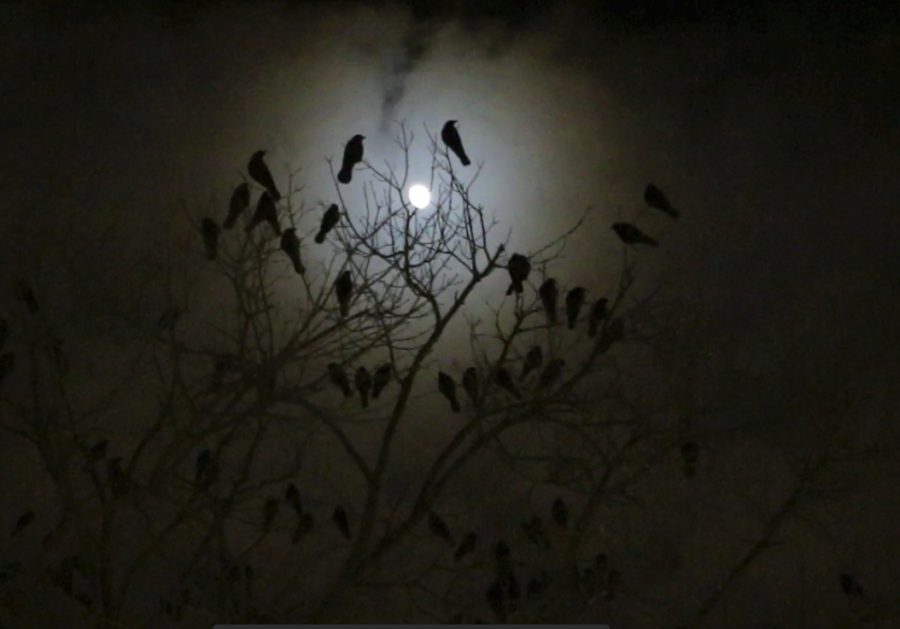As junior Virginia Lefever walked out of her Vertebrate Morphology lab in Langley Hall on a Tuesday night last semester, she heard what sounded like the onset of a minor rainstorm.
But it wasn’t raindrops plunking onto the pavement. It was crow feces.
“My friends and I liked to joke about needing an umbrella around campus. That’s what you have to do to get through [the crows],” Lefever, a biology and political science major, said.
Although campus looked like a scene from Alfred Hitchcock’s “The Birds” this past semester, the reason behind the crow’s prolonged stay — which was much longer than in years past — is no longer a mystery, thanks to work by the facilities management department and the National Aviary.
If you still see crows on campus now, National Aviary ornithologist — meaning a bird expert — Bob Mulvihill says not to fret, because they will return to their breeding areas soon, and only stop in Pittsburgh for the non-breeding season during the winter.
“Most of the crows they have here are from the farther north, and they kind of have attached to the crows who live here, but at the first sign of spring, a lot of the crows begin to break up at that point,” he said.
Crows in a city may seem rare — it’s noisy and filled with cars and airplanes that could hit them — but Mulvihill, who assisted facilities in solving the crow problem, said crows can be city slickers too. According to Mulvihill, the birds congregate in urban areas because they’re surrounded by their feathered friends, plentiful food, lots of artificial lighting and a plethora of buildings to keep them warm.
They usually stay up north near southern Ontario and parts of New England and, depending on what places they consider “safe,” only migrate a certain distance south, making Pittsburgh a prime vacation spot for crows — they know the area is safe from word of mouth, or, rather, beak.
“These communal roosts are not only safer for individual crows, but serve as a crow version of Facebook,” Mulvihill said. “It’s where they hear about what’s going on from everybody, it’s where they find out about feeding and roosting opportunities. Whatever conversations they’re having, it’s happening in those roosts.”
According to Assistant Vice Chancellor for Operations and Maintenance Dan Fisher, Pitt last had a crow problem three years ago, with crows roosting in the trees and covering the sidewalks with their feces.
But the last crow-pocalypse wasn’t quite as dramatic, as they only stuck around for three weeks in the fall before leaving in the winter thanks to a sound system playing distressed bird calls to scare them away.
But this time, fleets of black birds have been painting the tree tops around campus since October. Though a soundtrack of great horned owl coos — crows’ predator — emanating from a speaker perched on the corner of the William Pitt Union have scared the crows further toward mid-campus, the bird infestation persists.
Before, there was only one sound system from 2013. Facilities placed this older sound system beside Heinz Chapel at the end of November 2016 to not disturb visitors during the landmark’s popular holiday season. When the crows spread their reach, facilities management ordered two more owl sound systems in January and placed them around campus wherever the crows roosted, usually near Clapp Hall or the William Pitt Union.
“Naturally, we would like [the crows] to leave campus, but our ultimate goal was to get them away from the populated areas — areas where we have a lot of staff, faculty and visitors walking,” Fisher said.
Although they aren’t near high-traffic areas anymore, the crows now roost around the Frick Fine Arts building. Facilities management doesn’t plan to move the sound system over to that area, Fisher said.
“There’s not a lot of damage being done to the grass toward that area. We’re concerned if we put machines over there, we don’t know where they would go to next,” he said.
Pitt’s facilities department has consulted with the National Aviary in the North Side and other groups for tips on dispelling the murder. Some suggestions include using loud noises to scare the birds, Fisher said.
Other universities, such as Penn State — where there was also a crow problem this year— use fireworks to scare the crows away. But Mulvihill suggested playing the horned owl call since it will scare the crows, not nearby people.
“If you were strategic with horned owl calls that would make them too nervous, even with the bright lights, to roost,” he said.
Heinz Chapel Director Pat Gibbons said it was especially important to dispel the crows from the chapel when they first came to campus.
“December is a heavy month,” she said. “We have weddings, but we also have all the Heinz Chapel Choir concerts and the Women’s Choral Ensemble concert, so you don’t want people coming in, and at night is where [the crows] come.
The crows seem to really like what Pitt has to offer — neither Carlow nor Chatham have had crow problems, according to spokespeople at both universities.
Facilities management conducts daily cleanings of sidewalks, stairs and bus shelters, University spokesperson Joe Miksch said, but this work is only done when temperatures are above 28 degrees so as to not create any ice.
Fisher said facilities has not calculated the total labor cost for cleaning the sidewalks, stairs and bus shelters. However, the sound units cost $602 each.
Although the crows may be annoying, and a bit expensive to disseminate, Mulvihill said they pose no health risk to people.
“Don’t worry about crows,” Mulvihill said. “To be quite honest, the crows are doing a service in terms of them being the garbage detail.”


